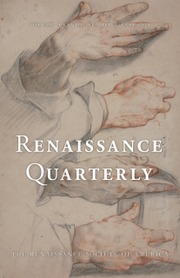This volume brings together eleven studies of the relationship between polyglossia, translation, and community formation in early modern England through a nuanced exploration of multilingual (rather than just bilingual) encounters. The editors center the volume’s capacious range of topics—from philology to science and natural philosophy to poetry to music to limning—around the concept of commonness, which they situate at the intersection of Benedict Anderson’s imagined communities, Neil Rhodes’s study of literary culture in the Renaissance, and work in translation studies by Mary Augusta Scott, F. O. Matthiessen, and Peter Burke.
The book is organized into four sections—“Roots, Germanic and Latinate,” “Language and Universality,” “Transnational Poetic Communities,” and “The Languages of Artistic Transfer”—each of which has a clear internal logic. The three essays of the first section are interested in etymologies, from Philip Durkin’s word histories of carry and douce, contextualized productively within larger lexical histories, to Jean-David Eynard’s analysis of Dekker’s Latin etymologies of cant words in Lanthorne and Candle-Light, to Iolanda Plescia’s analysis of roots, linguistic and otherwise, in Shakespeare’s Roman plays. The second section considers the relationship between translation and affiliation—religious, philosophical, and scientific. The three essays on Petrarchism, Ronsardism, and the Echo poem, which make up the third section, all theorize English ties to Continental poetic traditions through translation. The two essays on music and the visual arts in the final section clearly cohere around intermedial forms of translation/mission. The conceptual links across sections are less clear, but local connections between essays—Eynard’s interest in economic metaphors of coinage in Dekker, and Pádraic Lamb’s in accusations of theft in the English reception of Ronsard, for example—lend coherence to the collection as a whole.
Community rather than commonness becomes the clearest throughline, as each essay—tightly organized and well edited—works through a rich array of authors and texts. The specificity of each essay’s argument rarely feels cramped, and the payoff consistently appeals to scholars both within and beyond translation studies. The most interesting test cases trace the ways that a specific author, text, or language creates divisions in the act of forming new communities. Petrarch, for example, was so widely imitated that, Enrica Zanin and Rémi Vuillemin argue, his poetry became a kind of “transnational language” even as it “help[ed] fashion vernacular poetry in countries other than Italy” (189). Fabien Simon’s essay on John Wilkins’s universal language—which, used as a cryptographic code by Robert Hooke, ironically became “a secret language which no one could understand” (156)—also highlights tensions in the different ends toward which a language could be directed.
Some of the essays tend toward survey and taxonomy, however, emphasizing breadth of evidence at the expense of depth. Cassan’s very good essay on Bacon’s doctrine of idols, for example, would have benefited from a deeper exploration of etymologies. She contributes fresh insight into Bacon’s bilingual corpus by surveying all the places—both in English and in Latin—where Bacon mentions the idols, using this as an exemplary instance of Bacon’s general attention to language in the context of natural philosophy. Cassan posits an intellectual rather than cultural reason for Bacon’s choices—appealing to certain audiences, whether learned audiences addressed in Latin or otherwise in English, is less important in Bacon’s case than the relative affordances and limitations of specific languages to the study of nature. This is a worthy line of inquiry, but Cassan sometimes gives the impression that Bacon’s use of idola is new or unique (129–30) when, in fact, it had an established and relevant etymological history. It derives from the Greek εἴδωλον (image, likeness, image reflected in a mirror, image in the mind, and later, image of a god), transliterated into Latin as idolum or idolon (image). Several scholars have suggested Roger Bacon as one of Francis Bacon’s scholastic sources, and idola had an important technical meaning in Roger Bacon’s De multiplicatione specierum: idola are not just images, but specifically images that appear in mirrors. Francis Bacon uses the term punningly when he calls the mind an “uneven mirror” and refers to the distortions of the mind as “idols” (Novum Organum, trans. Graham Rees [2004], 79). It also seems relevant that idol was not a neutral term in post-Reformation England, and it would be worth knowing whether its English meaning left any religiously inflected residue on Bacon’s uses of idola in Latin.
The collection itself brings language communities newly into contact by virtue of the contributors’ own polyglottal expertise. Because the contributors work across multiple languages, not just in the primary but also in their secondary sources, readers will benefit from the wide array of sources cited, some available in English but others not.



